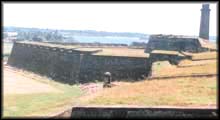 |
 14th March 1999 |
Front Page| |
 Crumbling |
Contents
|
|
 |
CrumblingCan you imagine Galle without those solid ramparts? Chamintha Thilakarathne reports on the monument that is crumbling due to erosion Behind its impressive facade, the Galle
Fort which was declared a world memorial site in 1991, is a threatened
monument. Chunks of its majestic Dutch-built ramparts have crumbled into the sea over the years. Now a rescue campaign is being launched with the Coast Conservation Department and the Archaeological Department joining hands to conserve the ramparts. The damage is not immediately apparent to a casual visitor, but the ramparts on several sides of the Fort have been badly affected by rough waves that thrash against it. The ramparts, built by Dutch architect Rish Lockvan Hoence and draughtsman Adrian Vender Maiden with granite stones of various shapes and sizes, stand many metres high, even taller than a fully grown coconut tree. The edges of the ramparts have been built with a cement like plaster, that helped keep the huge stones, some the size of a motor vehicle, intact. But over the years, water seeping through the ramparts has caused serious damage. The first section of the Fort built during the era of Parakramabahu the Ninth, is called the 'Black Fort' (this is on the north east side of the fort). In this section, an area 160 feet long, has been severely damaged by erosion. This is where the DIG's office is situated at present. T.A Ariyadasa of the Archaeology Department said that at this spot the sea water comes into the Fort through tunnels made by the waves. "Sometimes, the water comes into the Kachcheri also, Ariyadasa said. This is despite the conservation work done in a 100 feet by 20 feet area between the Black Fort and the warehouse. "If this had not been done in time, a large area of the rampart would have undoubtedly fallen to the sea," T.G.Nandasiri, a senior official of the Galle Archaeological Department said. He said that most of the buildings in this area are badly cracked and unsafe. According to these officials, the sea has eroded a five feet high area of the Divisional Secretariat building side of the Fort, while another damaged area, about 17 feet long, by 15 feet tall, about the size of a lorry, awaits conservation work. In the 'Triton Bastion', on the southern side of the Fort, although 120 feet of the ramparts has already been reconstructed, officials fear there is a possibility that the upper part may break away. With the waves crashing hard at the bottom of the ramparts for years, the foundation stones along with some stones in the middle of the ramparts have been dislodged, causing the upper parts of the ramparts too to crack. And the cracks are deep. Director of the Coast Conservation Department, Nissanka Perera says that waves hitting the ramparts and the water seeping through the stones have been the main reasons behind the rapid deterioration. According to him, there are huge craters in some parts of the Fort which have also been created by the waves. "We have already placed gabions to protect the ramparts which are likely to come down," Mr.Perera said. He said these emergency protection measures have cost approximately Rs.3 million, but it is upto the Archaeological Department to rebuild the ramparts that have been severely affected. "All that we can do from the point of coast conservation is to prevent the strong waves from reaching the rampart foundation and help rebuild the areas already damaged due to sea erosion. The emergency protection measures would assist the Archaeology Department to rebuild the ramparts from there," he said. But it's not so easy. The ramparts cannot be reached from within the Fort, only from the sea side. Mr. Perera explained there are difficulties in continuing work as the 90 degree angle of the ramparts make climbing difficult. Special machinery is being used to restore the walls, while equipment and workers have to be transported by boat. Officials say the lack of public co-operation has made their job more difficult. "If people could avoid some paths it would help," Mr.. Perera said. "These sea side walks on the ramparts are popular because of the view. But people also throw things to the beach and even break off parts of the upper walls." Gamini Wijesuriya, project co-ordinator for the Archaeology Department in Colombo said they are weighing the methods and material needed for the conservation of the Fort ramparts. Although a final estimate has not been made, the State Engineering Corporation puts the cost at around Rs 27 million. The Archaeological Department is looking into the possibility of filling the cracks with cement. Water seeping through remains a problem as is finding substitutes for the heavy stones that have broken away. The lack of manpower to monitor the damaged areas is another drawback. Meanwhile, the rest of Galle Fort too is in need of conservation. Many of the old Dutch buildings are being illegally destroyed by new residents who find no pleasure in the architecture of a bygone era. Officials of the Archaeology Department, say there is little that can be done to save these buildings and culture that once attracted both local and foreign tourists to the Fort. The Galle Fort covers an area of 96 acres with a circumference of two miles. At present, it is the only life memorial in the world and was also included in the UNESCO World Heritage List of Monuments in 1988. It was registered as an archaeological memorial by the Archaeological Department in 1974 but officials say the Rs. 2-3 lakhs each year spent on conservation of the Fort area is insufficient.
More Plus * A lonely man, lost and confused in a desert land * It's handsome and informative
Front Page| News/Comment| Editorial/Opinion| Business| Sports | Mirror Magazine |
|
 |
Please send your comments and suggestions on this web site to |
|